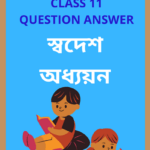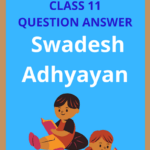Class 11 Swadesh Adhyayan Chapter 6 Society and Social Characteristics, Class 11 Question Answer to each chapter is provided in the list of AHSEC so that you can easily browse through different chapters and select needs one. Class 11 Swadesh Adhyayan Chapter 6 Society and Social Characteristics Question Answer can be of great value to excel in the examination.
Class 11 Swadesh Adhyayan Chapter 6 Society and Social Characteristics Notes covers all the exercise questions in HS 1st Year Swadesh Adhyayan Textbooks Solutions. Assam Board Class 11 Swadesh Adhyayan Chapter 6 Society and Social Characteristics provided here ensures a smooth and easy understanding of all the concepts. Understand the concepts behind every chapter and score well in the board exams.
Society and Social Characteristics
Chapter – 6
SWADESH ADHYAYAN
1. Who wrote Tabaquat -i- Nasiri?
Ans. Minhaj-us -siraj.
(2) What were the routes through which the Mongolian people entered Kamrup?
Ans. (i) Patkai Pass.
(ii) Sea route/Bay of Bengal.
(iii) Borders of Assam Burma.
(iv) Brahmaputra and Ganga valley.
(c ) Who introduced the Paik System?
Ans. Momai Tamuli Barau 1608 AD during the reign of Swargadeo Pratap Singha.
(d) What were the categories of Pails?
Ans. Kori and Chamua.
3. Give a brief idea of the migration of people to North East India.
Ans. Geography, entire North earth India lies at one of the important migration routes. That’s why, migration of people to his place occurred throughout the ages from Southeast Asia Southern Oceanic places and other part of India. Schoolars surmise that these migration of people probably took place through three or four entry routes. There is an evidence of communication of the region with Tibet, Nepal, Bhutan and China through the passes in the northern mountain ranges. Minhaj-us -Siraj in his book Tabaquat -i-Nasiri mention 85 mountains passes through which communication was possible through between kamrup, Darrang, Goalpara and North Bengal with Tibet and other neighbouring South East Asian Countries.
Moreover there was communication between Northeast India and Burma through the mountain ranges , especially the Patkai pass, located between the two region . The migration of the Tibetians- Burmese people belonging to the mongoloid race took place through through these mountain passes. Even in the present , human migration and assimilation is seen place through the borders of Assam-Burma. (Myanmar, Manipur or Nagaland) . The second route was through the Brahmaputra and Ganga valleys throughout the ages the waterways of both these rivers rivers have helped maintain communication of the North East with other places of India. The Aryan speaking people entered Assam through the route. The third route was the sea-route . Many people from south east Asia south India and Coastal areas entered North East India through the Bay of Bengal. Scholars assume that the Austric speaking Khasi Syntengs were the earliest group of migrants through the routes.
4. Write a note on the contribution of the Mongoloid people in the nation-making process.
Ans. Most of the groups from the hills and the plains in the North East belong to the Tibets Burmese section of the Indi-Chin branch of the Mongoloids which is evident from folk culture and anthropological sources the Ahom migrated in Assam to the first part of the 13th century also belong take Indi-Chinese group along with the Khamtis, PhokiolsArtesians, Khamyangs etc . It is also assumes that the earliest indigenous inhabitants of Assam and the Mongoloids. During the ancient and mediaeval periods they were politically powerful and they extended their kingdom. Scholars state that the Kiratas mentioned in the Ancient Sanskrit literacy were the Bodos including the entire Mongoloid are the largest in number in terms of the migrants who entered Brahmaputra valley. The influence of the Mongoloids in the indigenous culture of North East in general and Assam in particular has been greater than the other communities It’s reflects unity in diversity among the different communities in Assam with passes of home . Ge Mongoloids people contributed many political doctrine rituals and beliefs economic and social culture and many ideas in the nation making process.
(4) Discuss the changes brought about by the advent of Indian culture in Kamrup.
Ans. With the arrival of the Brahmas in Assam the traditional culture went through a series of changes. The Aryans Sanskritised the Non Aryan leaders by converting them as Hindus which somehow ignited tussles in between the Brahaman priestly (Purohit) class and the tribals. The Aryans also elevated the status of the Non-Aryan Kings and designated them as Kshatriyas . With the help of their economic powers and diplomacy, this priority class established the first Aryan Kingdom in the Brahmaputra valley which in turn resulted in the association of the Kings and their families with the Hindu Gods and goddesses and they also come to the identified as Hindu. The belief and practices of the indigenous people were also quite different were basically were treated with respect. Goddess Kamakhya and Bihu epistemology such beliefs. The tribal names of river and places were also changed to Sanskrit. With new ideas of policy and administration two strong forces emerged in the society. They were
Caste system or Varnashrama Dharma
(b) Class division among the people.
High and low divisions were divisions were created among the newly created castes. Those who rose high positions and those who stayed low had to remain in low position. Along with these many other changes were brought in Kamrup by the advent of Indian culture
5. What is the Paik system? How was it necessary for the agricultural society of mediaeval Assam.
Ans. In 1603 AD during the reign of Swargadeo Pratap Singha. Momai Tamuli Borua formally introduced the Paik System. People belonging to age group 16 to 50 were recruited as Paiks and each Paik individually had to provide service to the King for three months a year. This practise is referred to as the Paik System.
The Ahoms who entered Assam in 1228 CE were primarily agriculturalist . As the Ahoms had the knowledge of advance agricultural techniques they utilised these lands from the very beginning and introduced settled agricultural practices developing the productivity over time. The entire force was primarily engaged in agriculture which made it difficult for them to we the same force for military protection. This led to the creation of the Paik System which introduced the computer participation.

Hi! my Name is Parimal Roy. I have completed my Bachelor’s degree in Philosophy (B.A.) from Silapathar General College. Currently, I am working as an HR Manager at Dev Library. It is a website that provides study materials for students from Class 3 to 12, including SCERT and NCERT notes. It also offers resources for BA, B.Com, B.Sc, and Computer Science, along with postgraduate notes. Besides study materials, the website has novels, eBooks, health and finance articles, biographies, quotes, and more.






